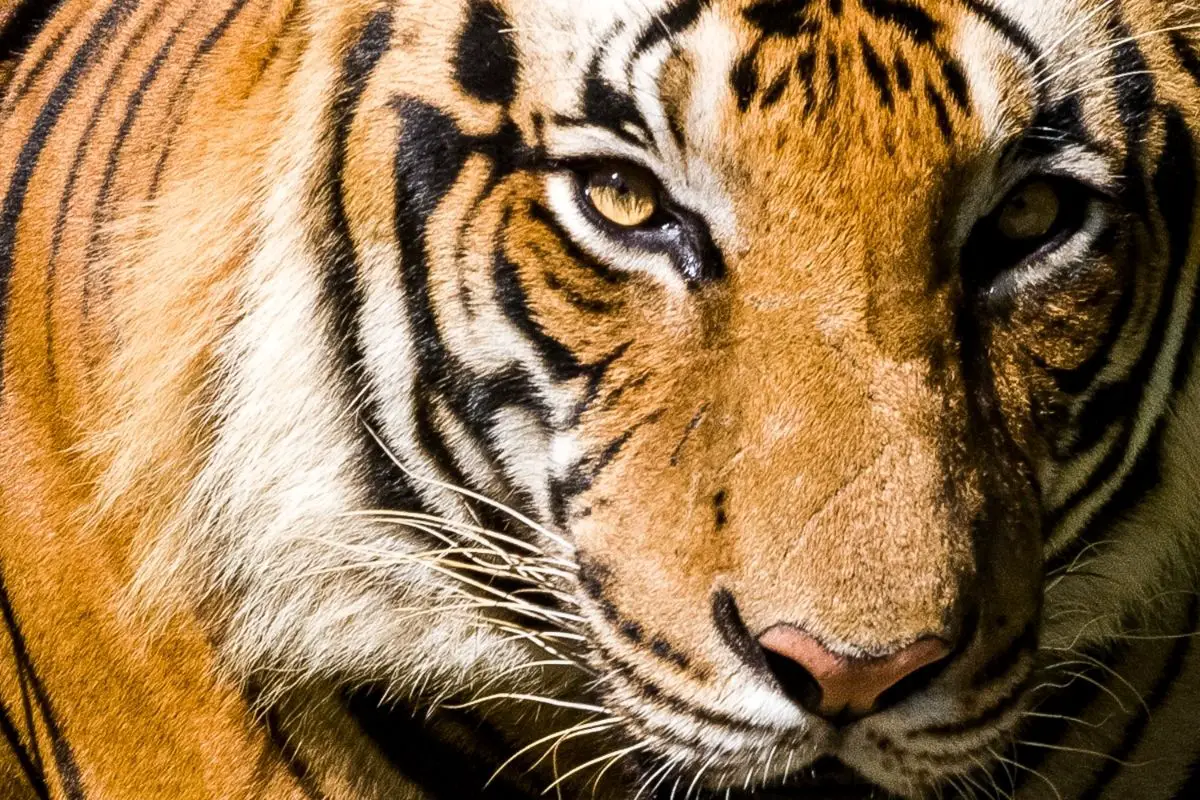A tiger’s fur is one of its most iconic features. The orange and black stripes are synonymous with tigers, and help make tigers the unique and fascinating animals we know and love.
But have you ever wondered why exactly tigers have orange fur? After all, it’s a fairly strange and unique color to see on a big cat. Well, the answer is actually pretty interesting.

If you’re interested in learning about why a tiger has its unique orange and black pattern, then you’ve come to the right place!
In this article, we’ll take a look at why tigers have orange fur, from the science behind its color to the advantages it gives tigers as a predator. So read on, and join us as we find out why tigers are orange!
Why Is A Tiger’s Fur Orange?
Tigers are apex predators, and as such are highly specialized for hunting their prey. You can see these evolutionary advantages in their immense strength, speed, and stealth, all of which help them take down prey with ease.
A tiger’s fur is another key part of their predatory toolkit, and serves as camouflage to help them blend in with the environment when stalking prey.
You can see (or rather, not see) how a tiger’s fur can help them camouflage against light and grass or undergrowth, where the orange and white tones in the fur helps the tiger blend in.
But tigers primarily hunt in the jungle, so surely bright orange will stand out, right? Well, while that would normally be the case for humans, a tiger’s prey doesn’t have the same eyesight as us.
Unlike humans, who have trichromatic vision, most land mammals like deer and boar only have dichromatic vision.
This means that they only have two color receptors in their eyes, making it hard to distinguish between reds and greens; essentially, they are colorblind.
As a result, a tiger’s fur actually appears green instead of orange! This makes them much better at blending into the jungle’s undergrowth where they can stealthily sneak up on their unsuspecting prey.
The green fur combined with the tiger’s other stripes provides incredible camouflage, and makes them nearly impossible to spot against the dense jungle.
What Causes A Tiger’s Fur To Be Orange?
So now that we understand why tigers have orange fur, let’s take a look at why their fur is orange – from a scientific perspective.
Tigers are unique amongst big cats for their coloration; even species like leopards and cougars, who have similar colors on their fur, are more of a beige than a bright orange. So what makes tigers so different?
A tiger’s orange fur is caused by a special pigment known as pheomelanin. The pheomelanin levels in their fur give tigers a vibrant orange, due to increased levels of red hues.
It’s most likely that tigers evolved to produce more pheomelanin in their fur so they could get this orange coloration as a hunting tactic, adapting to suit their verdant surroundings.
You might be wondering why tigers didn’t evolve to develop green fur instead, but the answer’s actually pretty simple; mammals just aren’t able to produce green fur naturally!
No mammal grows naturally green hair – even sloths, which grow patches of green in their fur, aren’t actually green and just host a species of algae in their fur.
Because of their habitat, tigers evolved their orange fur to blend in with their green surroundings. This is similar to how other animals have natural camouflage.
For instance, zebras also use their stripes to blend in with the tall grass in their savanna habitat (though this is to hide from predators instead of for hunting), while chameleons can actively change their color to help them hunt prey and avoid predators.
How Does Prey See (Or Not See) A Tiger?

As dichromatic creatures, a tiger’s typical prey of deer, hog, and sambar will have a hard time spotting it. Because of how vivid a tiger’s orange pigment is, it will blend in with the jungle’s bright greens incredibly.
This is a vital part of the tiger’s hunting strategy, which prioritizes stealth.
Like other big cats (and even domestic cats), tigers use their cushioned footpads and agile frame to sneak up on their prey. Without being able to hear or see the tiger, prey will be unable to detect the tiger until it’s too late.
The combination of its camouflage and other hunting advantages makes tigers incredible predators.
While dichromatic animals such as deer or boar would be able to spot a tiger better in dry grass because of how the green would stand out, they don’t have the same luck in a tiger’s preferred hunting ground of the jungle.
Ironically, because tigers are also dichromatic animals, they wouldn’t even be aware that they’re orange – to each other, they also look green!
Are Tigers Orange With Black Stripes Or Black With Orange Stripes?
It’s an age-old question, but the answer is that tigers have orange fur with black stripes on them. Having more orange than black is an advantage for tigers, as the green will blend in better against the jungle.
With that said, however, a tiger’s black stripes are also useful and help break up the pattern of their fur to give them even better camouflage.
Not all tigers have orange and black fur – Bengal tigers have brown stripes instead of black ones, while the golden tiger has its eponymous golden fur with cinnamon-colored stripes.
White tigers, as the name suggests, have bright white fur with black stripes; however, this is a result of genetic mutation and are typically bred to have this coloration.
Final Thoughts
Tigers are one of the most beautiful animals in the world, and their stunning and unique fur really helps them stand out.
Their iconic fur is a valuable tool that helps them camouflage while hunting their prey, and is a result of evolutionary changes helping them to adapt to their environment.
So now you know a bit more about why tigers have orange fur, you can look at these incredible animals in a new light!
- Sink Your Teeth Into This: Analyzing the Powerful Lion Bite Force - September 8, 2023
- Siberian Tigers: Everything You Need To Know - September 4, 2023
- Do Lions Eat Humans? Understanding Lion Aggression and Risks - September 4, 2023









